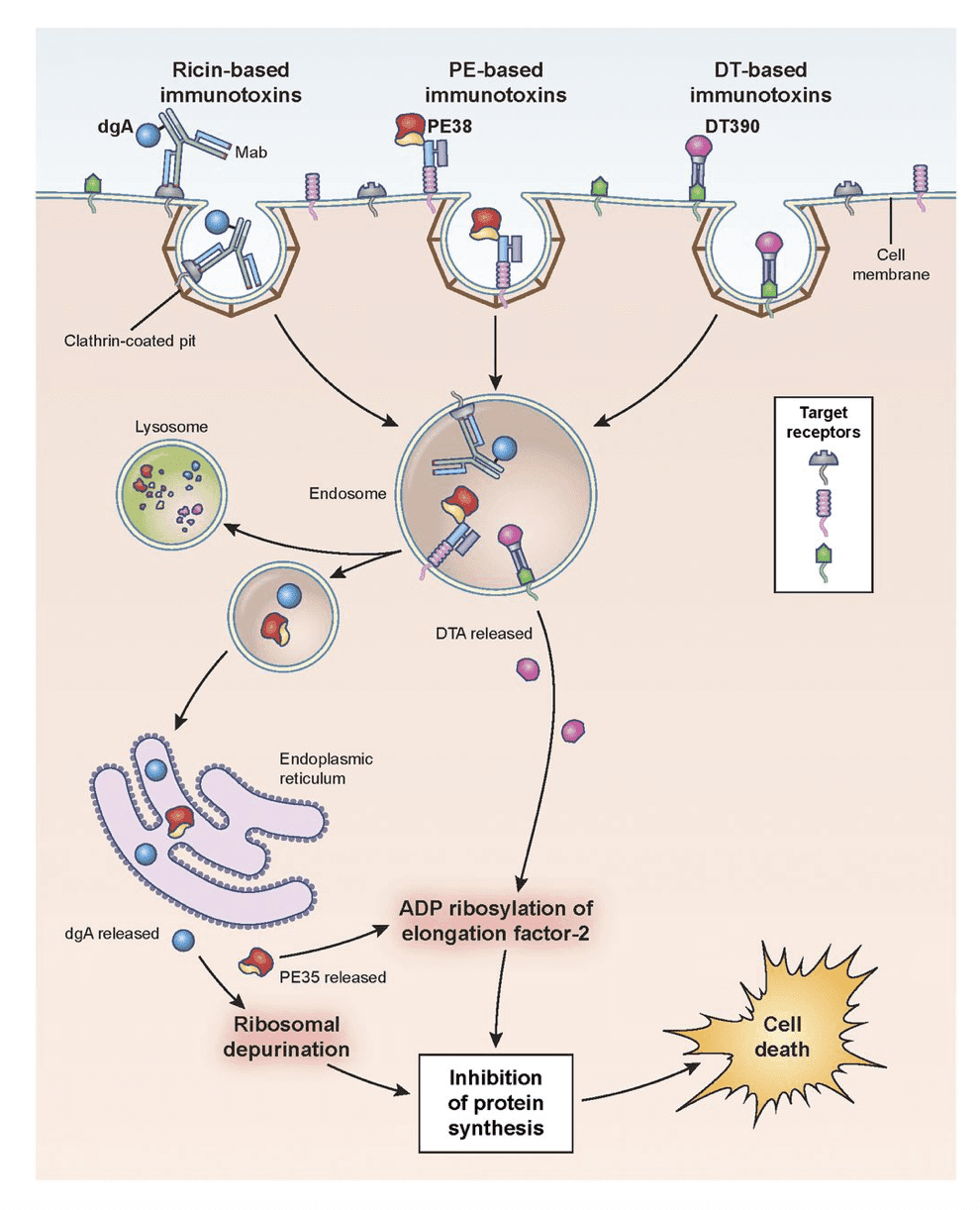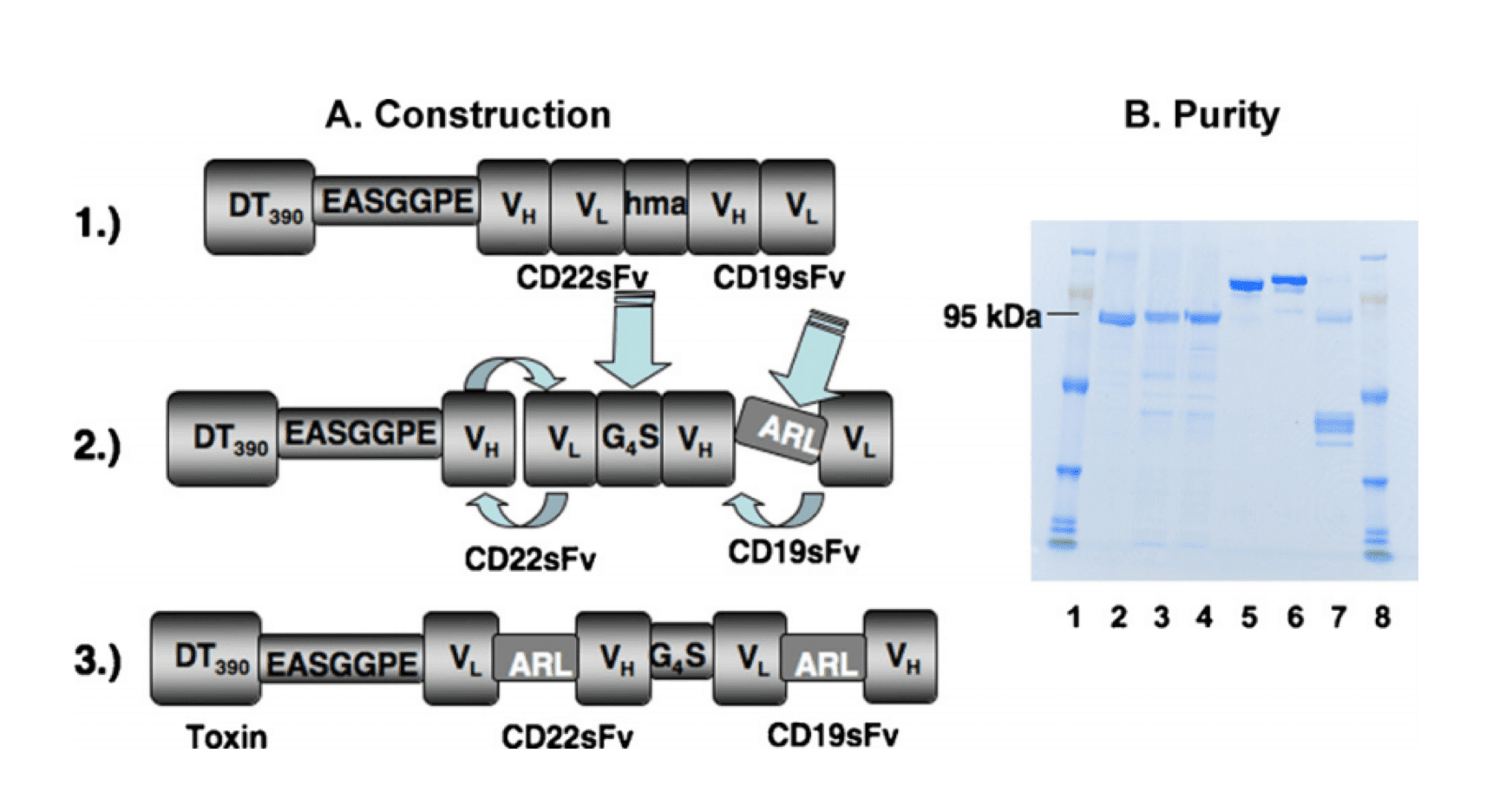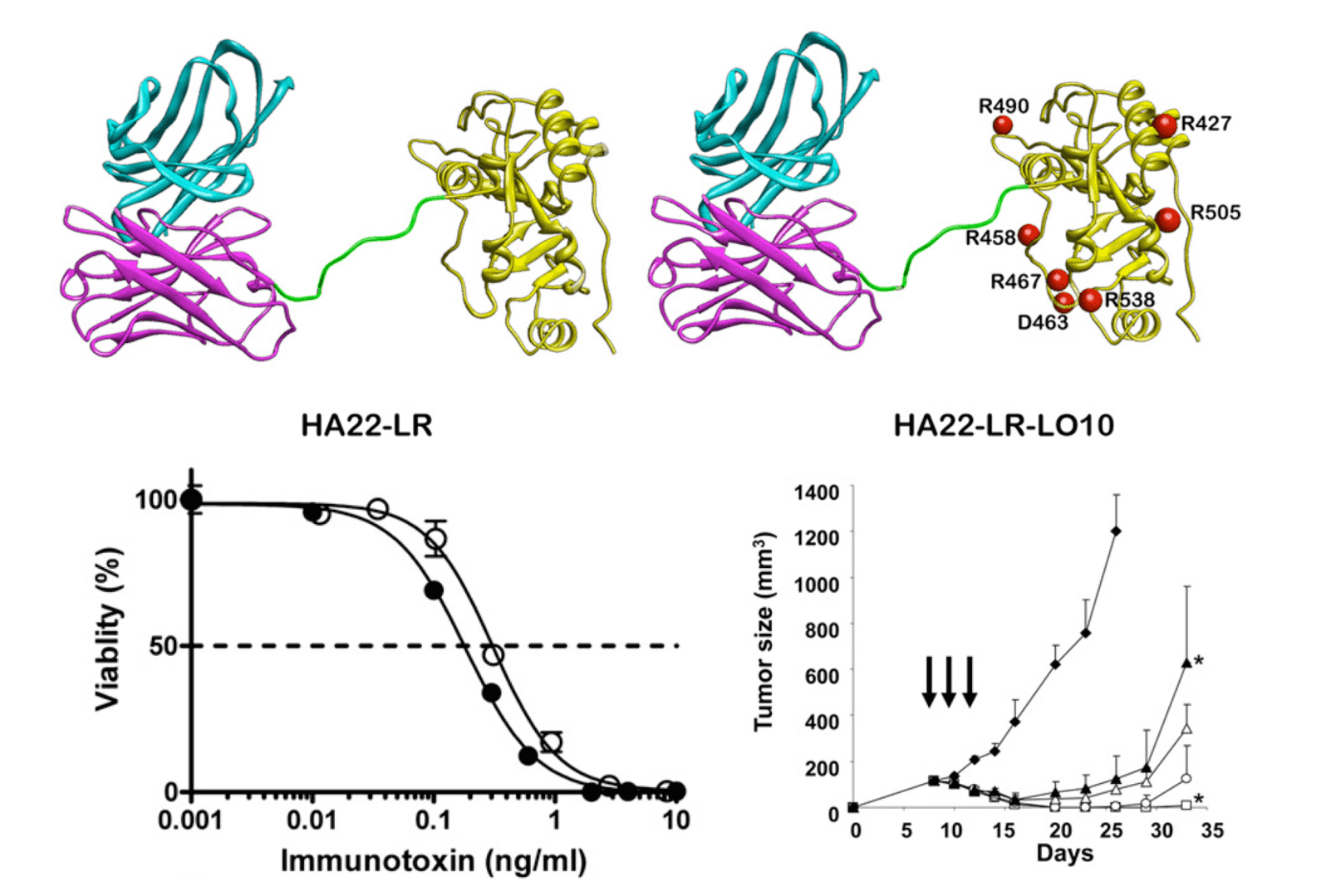Protein Toxins
As a leader in recombinant antibody engineering and production, Creative Biolabs now offers services that integrate protein toxins into full antibody, antibody Fab regions, scFv, single-domain antibodies… as a novel form of antibody-drug conjugates (ADCs) for targeted drug developments.
Protein toxins are usually produced by bacteria or plants. Many bacterial toxins are comprised of two parts: the cell binding portion interacts with cell surface while the enzymatic portion enters the cytosol and generates toxicity. Common protein toxins include pseudomonas exotoxin (PE), diphtheria toxin (DT) and ribosome-inactivating proteins (RIPs). Protein toxins are potential payload candidates for immunotoxin conjugates (ITCs) and ADCs.
 Pathways for protein toxin mediated cell death. Protein toxins enter target cells via receptor mediated endocytosis and trigger cell death by inhibiting protein biosynthesis (Blood, 2014).
Pathways for protein toxin mediated cell death. Protein toxins enter target cells via receptor mediated endocytosis and trigger cell death by inhibiting protein biosynthesis (Blood, 2014).
Diphtheria Toxin (DT)
DT is an extracellular protein from Corynebacterium diphtheriae that restrains protein synthesis and kills suspected cells. The essential factor of the protein synthesis machinery restrained by DT has been confirmed as elongation factor 2 (EF-2), while the presence of nicotinamide adenine dinucleotide (NAD) is required for DT protein synthesis inhibition. Furthermore, DT was proved to act catalytically through transferring the adenosine diphosphate ribose (ADPR) portion from NAD to EF-2, therefore inactivating EF-2 and restraining chain elongation during protein synthesis. OXS-1550, a bispecific scFv recombinant fusion protein, has been designed as a new therapy for the treatment of leukemia and lymphoma. It is comprised of a modified form of DT as its drug payload and the variable regions of the heavy and light chains of anti-CD19 and anti-CD22 antibodies, respectively. OXS-1550 revealed good efficacy in early clinical trials against relapsed and refractory B-cell lymphoma or leukemia.
 Construction of DT2219EA, a bispecific antibody-DT fusion protein.
The initial DT2219EA construct comprising of the first 389 amino acids of the DT, the VH and VL regions of anti-CD22
(sFv) and anti-CD19 linked by a 20-amino acid segment of human muscle aldolase (hma). To produce DT2219ARL,
the original VH-VL orientation was reversed and the VL and VH genes of each sFv were conjoined by a
fragment encoding the ARL linker. The final target gene was spliced into pET21d vector.
The lane 2 of part B is the DT2219ARL, about 95 kDa (Leukemia Res, 2009).
Construction of DT2219EA, a bispecific antibody-DT fusion protein.
The initial DT2219EA construct comprising of the first 389 amino acids of the DT, the VH and VL regions of anti-CD22
(sFv) and anti-CD19 linked by a 20-amino acid segment of human muscle aldolase (hma). To produce DT2219ARL,
the original VH-VL orientation was reversed and the VL and VH genes of each sFv were conjoined by a
fragment encoding the ARL linker. The final target gene was spliced into pET21d vector.
The lane 2 of part B is the DT2219ARL, about 95 kDa (Leukemia Res, 2009).
Pseudomonas Exotoxin (PE)
PE is an exotoxin produced by Pseudomonas aeruginosa and belongs to the two-component AB toxin family that contains an A domain with enzymatic activity and a B domain as cell binding subunit. PE has an extremely hydrophobic leader peptide of 25 aa at its N-terminus, followed by the receptor binding domain Ia (aa 1-252) that is comprised of antiparallel β-sheets. The second part of PE, Domain II (aa 253–364), contains six consecutive α-helices and allows the translocation of the toxin across cell membranes. PE also affects protein synthesis and doing so by restraining EF-2 via ADP-ribosylation, resulting in the termination of polypeptides elongation. PE has been applied in targeted anti-cancer therapy, with two scFv-PE fusion proteins, currently under clinical evaluation.
 Antibody therapeutics generated by fusion of an anti-CD22 scFv with pseudomonas exotoxin A and a mutated version of pseudomonas exotoxin A. Both conjugates show similar cytotoxicity against CD22+ cancer cells in vitro and CA46 tumors in vivo (PNAS, 2012).
Antibody therapeutics generated by fusion of an anti-CD22 scFv with pseudomonas exotoxin A and a mutated version of pseudomonas exotoxin A. Both conjugates show similar cytotoxicity against CD22+ cancer cells in vitro and CA46 tumors in vivo (PNAS, 2012).
Ribosome-inactivating Protein (RIP)
Ribosome-inactivating proteins (RIPs), including ricin, abrin, and saporins, etc, are catalytic toxins which irreversibly inactivate protein synthesis. Most RIPs were isolated from plants and they were also discovered in fungi, algae and bacteria. They have been demonstrated to exert RNA N-glycosidase activity and depurinate the 28S rRNA of the large 60S ribosomal subunit in eukaryotic cells. Among these RIPs, the toxin ricin derived from Ricinus communis has been studied most extensively as cytotoxic payloads. For example, combotox, an ADC consists of two murine monoclonal IgG1 antibodies: a CD22 antibod (RFB4) and a CD19 antibody (HD37), both of which are individually conjugated to a ricin-based toxin: deglycosylated ricin-A chain (dgRTA), through a heterobifunctional, thiol-containing cross-linker. Combotox has been shown to be effective in a Daudi-Lymphoma (CD19+/CD22+) SCID mouse model, and the combined use of antibodies revealed a synergistic killing effect.
With our well-established recombinant antibody engineering and “DrugLnk” organic synthesis platforms, the experienced scientists here at Creative Biolabs is dedicated to help our clients develop antibody-targeted drugs containing protein toxin in a timely and cost-effective manner. Our customarily tailored services and high quality products will contribute greatly to the success of your projects.
Creative Biolabs also provides other various services regarding ADC development. Please feel free to contact us for more information and a detailed quote.
References:
- Murphy, J.R.; et al. Mechanism of diphtheria toxin catalytic domain delivery to the eukaryotic cell cytosol and the cellular factors that directly participate in the process. Toxins. 2011, 3(3): 294-308.
- Michalska, M.; et al. Pseudomonas Exotoxin A: optimized by evolution for effective killing. Front Microbiol. 2015, 6: 963.
- Walsh, M.J.; et al. Ribosome-inactivating proteins: potent poisons and molecular tools. Virulence. 2013, 4(8): 774-784.
- Vallera, D.A.; et al. Genetic alteration of a bispecific ligand-directed toxin targeting human CD19 and CD22 receptors resulting in improved efficacy against systemic B cell malignancy. Leukemia Res. 2009, 33(9): 1233-1242.
- Wayne, A.S.; et al. Immunotoxins for leukemia. Blood. 2014, 123:2470-2477.
- Liu, W.; et al. Recombinant immunotoxin engineered for low immunogenicity and antigenicity by identifying and silencing human B-cell epitopes. PNAS. 2012, 109(29): 11782–11787.
For Research Use Only. NOT FOR CLINICAL USE.
Related Sections
DrugLnk™ Custom Synthesis: One-stop ADC Development Service:
Welcome! For price inquiries, please feel free to contact us through the form on the left side. We will get back to you as soon as possible.
Contact usUSA
Tel:
Fax:
Email:
Europe
Tel:
Email:
Germany
Tel:
Email:

